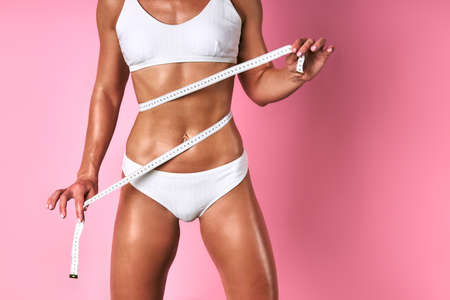1. Understanding Cellulite: Causes and Myths
Cellulite is a common concern, especially among women, but there are many misconceptions about what it is and why it forms. To better understand how diet and exercise can help reduce cellulite, lets first explore its causes and debunk some common myths.
What Is Cellulite?
Cellulite appears as dimpled or lumpy skin, often on the thighs, buttocks, abdomen, and arms. It occurs when fat deposits push through the connective tissue beneath the skin. While cellulite is completely normal and harmless, many people seek ways to minimize its appearance.
Causes of Cellulite
Several factors contribute to the development of cellulite. These include:
- Genetics: Your genes play a major role in determining your likelihood of developing cellulite.
- Hormones: Estrogen, insulin, and other hormones influence fat storage and connective tissue structure.
- Lifestyle Factors: Poor diet, lack of exercise, dehydration, and high stress levels can all contribute to more visible cellulite.
- Aging: As we age, our skin loses elasticity, making cellulite more noticeable.
Common Myths About Cellulite
There are many misconceptions about cellulite. Lets separate fact from fiction:
| Myth | Reality |
|---|---|
| “Only overweight people get cellulite.” | Cellulite affects people of all body types—even those who are slim or athletic. |
| “Drinking more water will eliminate cellulite.” | Hydration improves skin health but does not directly remove cellulite. |
| “Creams and lotions can completely erase cellulite.” | Topical treatments may improve skin texture temporarily but do not eliminate cellulite. |
| “Exercise alone will get rid of cellulite.” | While exercise helps tone muscles and reduce fat, it does not guarantee complete removal of cellulite. |
The Importance of a Holistic Approach
No single treatment will completely eliminate cellulite, but a combination of healthy eating habits, regular physical activity, and proper skincare can make a significant difference. In the next section, we’ll explore how specific dietary choices can help reduce its appearance.
2. The Impact of Diet on Cellulite Reduction
What you eat plays a huge role in the appearance of cellulite. While there’s no magic food that will make it disappear overnight, making smart dietary choices can help reduce its visibility over time. Focusing on hydration, anti-inflammatory foods, and avoiding processed and high-sodium foods can make a noticeable difference.
Hydration: The Key to Healthy Skin
Staying hydrated is one of the simplest yet most effective ways to improve skin health and reduce cellulite. Water helps flush out toxins, keep skin cells plump, and improve circulation, which all contribute to smoother-looking skin.
How Much Water Should You Drink?
Aim for at least eight 8-ounce glasses of water per day, but your needs may vary based on your activity level and climate. If plain water isn’t appealing, try adding lemon, cucumber, or mint for extra flavor.
Anti-Inflammatory Foods That Help Reduce Cellulite
Inflammation can worsen the appearance of cellulite by causing fluid retention and weakening connective tissues. Including anti-inflammatory foods in your diet can promote healthier skin and improve circulation.
| Food Type | Examples | Benefits |
|---|---|---|
| Healthy Fats | Avocados, nuts, olive oil | Supports skin elasticity and reduces inflammation |
| Leafy Greens | Spinach, kale, arugula | Packed with antioxidants that support collagen production |
| Berries | Blueberries, strawberries, raspberries | Rich in antioxidants that combat free radicals |
| Omega-3s | Salmon, flaxseeds, walnuts | Boosts circulation and strengthens skin structure |
Avoiding Processed and High-Sodium Foods
Processed foods and those high in sodium can lead to water retention, bloating, and poor circulation—all of which make cellulite more noticeable. Try to limit your intake of fast food, sugary snacks, and salty packaged foods.
Better Alternatives to Processed Foods
- Soda → Infused Water: Swap sugary sodas for naturally flavored water with fruits or herbs.
- Chips → Nuts or Seeds: Choose unsalted almonds or sunflower seeds for a satisfying crunch.
- Candy → Dark Chocolate: Opt for dark chocolate (70% cocoa or higher) instead of processed sweets.
- Fast Food → Home-Cooked Meals: Preparing meals at home gives you control over ingredients and sodium levels.
The Bottom Line on Diet and Cellulite Reduction
A balanced diet rich in whole foods, plenty of water, and reduced processed food intake can significantly impact the appearance of cellulite. Pairing these dietary habits with regular exercise will enhance results even further.
![]()
3. The Role of Exercise in Smoothing Skin Appearance
Regular exercise plays a key role in reducing the visibility of cellulite by improving muscle tone and circulation. When you engage in strength training, cardio, and targeted lower-body exercises, you help create firmer, more toned muscles that can smooth out the skin’s surface. Additionally, better circulation helps remove toxins and excess fluids that contribute to the dimpled appearance of cellulite.
Strength Training for Muscle Firmness
Strength training is essential for building muscle and tightening the skin. When muscles become stronger and more defined, they provide better support to the skin, reducing the look of cellulite. Some effective strength-training exercises include:
- Squats
- Lunges
- Deadlifts
- Step-ups
- Leg presses
Cardio for Fat Reduction and Circulation
Cardio exercises help burn fat and improve blood flow, which can make cellulite less noticeable. Activities like running, cycling, swimming, or brisk walking get your heart pumping and enhance circulation in areas prone to cellulite.
Best Cardio Exercises for Cellulite Reduction
| Exercise | Benefits |
|---|---|
| Running or Jogging | Burns calories and improves circulation |
| Cycling | Targets thighs and buttocks while improving endurance |
| Swimming | Tones muscles and increases blood flow without joint strain |
| Jump Rope | Engages multiple muscle groups and boosts circulation |
| Dancing | Fun way to stay active while toning legs and glutes |
Targeted Lower-Body Workouts
Since cellulite commonly appears on the thighs, hips, and buttocks, focusing on lower-body workouts can be particularly effective. Incorporating resistance bands or weights into your routine can further enhance muscle engagement.
Effective Lower-Body Moves:
- Glute Bridges: Strengthens the hamstrings and glutes while promoting circulation.
- Side-Lying Leg Lifts: Engages outer thighs and hip muscles.
- Banded Kickbacks: Tones the glutes and improves overall leg definition.
- Plié Squats: Targets inner thighs while enhancing flexibility.
- Calf Raises: Helps tone the lower legs for a smoother appearance.
By combining strength training, cardio, and targeted lower-body exercises into your fitness routine, you can significantly improve muscle tone and circulation. Over time, these efforts will contribute to smoother skin and a reduction in cellulite visibility.
4. Lifestyle Factors That Affect Cellulite
While diet and exercise play a major role in reducing cellulite, other lifestyle habits can also make a difference. Factors like stress management, sleep quality, and skincare routines contribute to overall skin health and may help minimize the appearance of cellulite.
Stress Management
Chronic stress increases cortisol levels, which can lead to weight gain and poor circulation—both of which contribute to cellulite formation. Managing stress effectively can improve skin health and overall well-being.
Ways to Reduce Stress:
- Meditation: Practicing mindfulness or deep breathing exercises can lower cortisol levels.
- Exercise: Physical activity not only reduces stress but also improves blood flow.
- Hobbies: Engaging in activities you enjoy helps relax your mind and body.
- Adequate Rest: Taking breaks and avoiding overworking yourself can reduce stress accumulation.
Sleep Quality
Poor sleep affects hormone regulation, leading to increased fat storage and decreased collagen production. Ensuring quality rest can support skin repair and reduce cellulite appearance.
Tips for Better Sleep:
- Create a Routine: Going to bed and waking up at the same time daily regulates your bodys internal clock.
- Avoid Screens Before Bed: Blue light from screens disrupts melatonin production, making it harder to fall asleep.
- Limit Caffeine Intake: Reducing caffeine consumption in the afternoon helps prevent sleep disturbances.
- Create a Relaxing Environment: A dark, cool, and quiet room promotes restful sleep.
Skincare Routines
A good skincare routine can enhance skin elasticity, hydration, and circulation—all of which help reduce the visibility of cellulite.
| Skincare Habit | Benefit |
|---|---|
| Dry Brushing | Stimulates circulation and exfoliates dead skin cells. |
| Coffee Scrubs | Caffeine temporarily tightens skin and improves blood flow. |
| Moisturizing | Keeps skin hydrated and improves its texture. |
| Lymphatic Massage | Aids in fluid drainage and reduces puffiness in affected areas. |
5. Setting Realistic Expectations and Alternative Treatments
While diet and exercise play a significant role in reducing cellulite, it’s important to set realistic expectations. Cellulite is a common condition that affects people of all shapes and sizes, and even the most disciplined fitness routine may not completely eliminate it. Understanding the limitations of diet and exercise can help you approach your body goals with confidence and self-compassion.
Understanding the Limitations of Diet and Exercise
Healthy eating and regular physical activity can improve skin elasticity, reduce fat accumulation, and enhance muscle tone. However, cellulite is not solely caused by excess fat—it’s influenced by genetics, hormones, and connective tissue structure. This means that even individuals who are at their ideal weight may still have cellulite.
How Diet and Exercise Help vs. Their Limitations
| Benefits of Diet & Exercise | Limitations |
|---|---|
| Reduces overall body fat, making cellulite less noticeable | Does not change how fat is distributed beneath the skin |
| Tones muscles, creating a firmer appearance | Cannot completely smooth out dimpled skin caused by connective tissue |
| Improves circulation and skin health | The effects vary from person to person based on genetics |
Aesthetic and Medical Treatments for Cellulite
If you’re looking for additional ways to minimize cellulite, various treatments are available. These treatments do not offer permanent results but can significantly reduce the appearance of cellulite for an extended period.
Popular Cellulite Treatments
- Cryolipolysis (CoolSculpting): Freezes fat cells to reduce localized fat deposits.
- Laser Therapy: Stimulates collagen production to improve skin texture.
- Radiofrequency (RF) Treatments: Tightens skin and improves elasticity.
- Massage Therapy: Enhances circulation and temporarily smooths skin.
- Caffeine-Based Creams: Temporarily tighten skin by improving blood flow.
The Importance of Self-Confidence and Body Positivity
No matter what approach you take, embracing your body is essential. Cellulite is completely normal and does not define your beauty or health. Instead of striving for perfection, focus on feeling strong, healthy, and confident in your own skin. Whether you choose diet, exercise, medical treatments, or a combination of approaches, remember that self-care should always be about what makes you feel good—not just about achieving a certain look.


